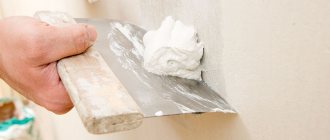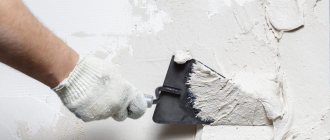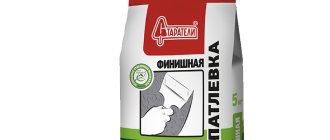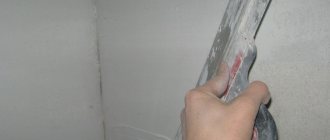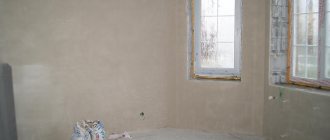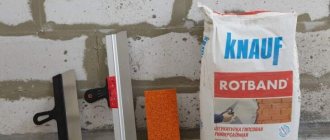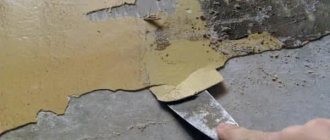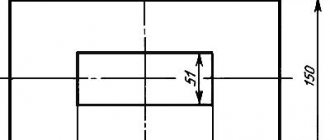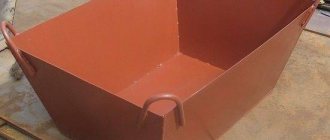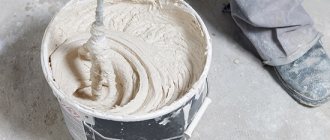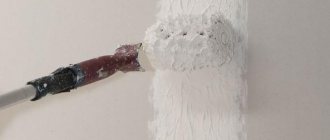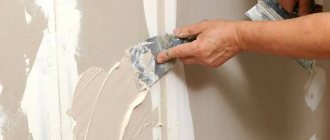Free online calculator to calculate flow putties Prospectors: Basic, Leveling, Gypsum Finish, Cement Basic Gray, Cement Basic, Facade Gray, Cement Facade, Facade Finish, Finish Kr, Finish Plus, Polyart, Superfinish. This calculator is designed to help make an approximate calculation of the amount of materials in kg per 1 m2 required for your repair, but it cannot take into account natural losses during use and the skill level of the technician.
How to apply
The mixture can be applied manually or mechanically.
Manual application
To do this, use a spatula or trowel. The mixture is applied in several layers, moving the tool from bottom to top. For the first layer, it is better to use a coarse-toothed trowel: it will provide better adhesion. After application, the surface must be leveled. The thickness of the applied layers is no more than 5 cm.
The ceiling is plastered by moving the spatula towards you. Apply only one layer of the mixture. The solution sets in two hours. If the layer is more than 2 cm, then reinforcement with metal mesh must be used. After 40 minutes, the solution sets, after which you can cut off the irregularities and smooth the surface with a spatula.
After the applied layer has dried, you can prepare the surface for final finishing. To do this, the plaster is moistened with water and rubbed with a grater. Then smooth the plaster with a wide spatula. Smoothing can be repeated after a few hours. After this treatment, the surface does not need to be puttied. Mechanical application
A few words about the manufacturer
The story began in 1992. The company was initially focused on the production of ready-made putties; subsequently, the product range began to expand. In the 90s of the last century, this area of the construction market was not yet developed, so it was necessary to use the experience of European manufacturers. The company learned from the mistakes of others, introducing its own technologies and implementing a computerized quality control system.
Currently, the company works according to its own recipe, using only high-quality raw materials. This helped us become the largest manufacturer and supplier of ready-made dry mixes.
What's included
The composition of the Starateli starting dry mixture is based on white cement, which expands the scope of application and speeds up the finishing time. Unlike plasters based on gray Portland cement, this mixture is light beige in color, so finishing begins immediately after the starting putty has dried. Judging by the composition, the Starateli mixture is more likely to be a dry plaster, but unlike plasters, it is plastic, which is inherent in putties. This explains the versatility: the Starateli mixture combines the moisture resistance inherent in plasters and the leveling properties characteristic of gypsum putties.
Example of surfaces
The mixture contains sifted and purified sand with a maximum fraction size of 0.4 mm.
In addition to ground clinker and gypsum, the putty formulation contains additives that improve elasticity, prevent shrinkage during drying and repel moisture. The Starateli mixture uses European polymer plasticizers and additives, “Wacker”, “Rhodia”.
Starting putty belongs to modified mixtures, since marble flour, cellulose ethers and fine sand are added to it, which helps retain moisture and allows the putty to be applied in a layer of up to 1 cm.
This is interesting: Why do you need to prime the walls before plastering?
Main properties and reviews about them
The basic putty “Starateli” is made on the basis of a time-tested recipe. Among the main properties of the product are:
- plastic;
- waterproof;
- high adhesion.
As for plasticity, the mixture can be spread in a continuous thin layer, which is the main advantage. Application can be carried out using putty tools such as a spatula or grater. On large surfaces, the composition is leveled without slipping or scuffing.
Reading reviews about the basic putty “Prospectors”, you can understand that it is quite often compared with gypsum putties, which have less impressive adhesion to an unprimed surface. Consumers also like water resistance. When dry, the layer does not form pores. It is easy to sand until the grooves and bumps disappear.
The material can be used both outside and indoors. It does not crack if applied in a thick layer. The mixture does not shrink. In this regard, according to consumers, it can be used to level walls with large differences and flaws.
Types and characteristics
Currently it produces the following types of finishing compositions:
- “Finishing putty”;
- “Facade finishing putty”;
- “Finishing Putty Plus Moisture Resistant”;
- “Ready putty Superfinish”;
- "Finish putty KR".
“Finishing putty” is a dry white gypsum mixture used for plastering indoor surfaces.
The composition includes modifying additives.
The recommended thickness of the applied layer is 0.3-5 cm. The material consumption, subject to this condition, will be 900 g per square meter of surface.
Can be applied to plastered, concrete and brick substrates for subsequent painting or wallpapering.
The use of this material in places where there will be contact with food or drinking water is not permitted.
This type of putty is applied to a dry, clean and strong base. If the base has crumbling or unreliable areas, they should be removed. Gypsum and other hygroscopic substrates must be pre-treated with a primer.
The putty solution is prepared at the rate of 400-580 ml of water per kilogram of dry matter.
This type of material is sold in containers of 5, 12 and 20 kg.
“Facade finishing putty” is a mixture for carrying out plastering work mainly on the outside of the building. The material is also suitable for interior work.
The functionality determines the following properties of this product: frost resistance, weather resistance, resistance to cracking.
The facade-finish mixture includes white cement, modifying additives and fine natural filler.
The finishing coating can be applied to cement, concrete and reinforced concrete bases for subsequent application of decorative plaster, painting and wallpapering.
Suitable for application in damp areas. Not recommended for use in areas where food contact is expected.
The recommended thickness of the applied layer is from 0.3 to 3 mm. Consumption is kilogram per square meter with a putty layer thickness of 1 mm.
The solution is prepared at the rate of 320-400 ml per kilogram of dry powder.
The prepared solution remains viable for three hours from the moment of mixing.
Packaging – only in bags of 20 kg.
“Finishing Putty Plus Moisture Resistant” is a white polymer-cement plastic material with increased moisture resistance.
Can be applied to substrates covered with gypsum plaster, concrete and plasterboard.
The thickness of the putty layer recommended by the instructions is 0.3-3 mm. Material consumption – 800 grams per square meter (layer thickness 1 mm).
The base for applying the solution is prepared in the same way as finishing putty.
The solution is prepared at the rate of 350-400 ml per kilogram of dry powder.
The prepared solution remains viable for six hours from the moment of mixing.
“Ready putty Superfinish.” This material is a ready-made putty mixture in the form of a paste.
Its composition includes: reinforcing fibers, a polymer binder, fine fillers, antiseptic fractions and modifying additives.
Ready-made paste is used only for interior work in rooms with normal humidity levels. Apply to plasterboard bases, gypsum plaster, tongue-and-groove boards, fiberglass. The subsequent coating can be in the form of wallpaper or a paint layer.
The recommended maximum thickness of the applied putty layer is 2 mm. Paste consumption with a putty layer of 0.3 mm is 500 g per square meter.
Adhesive ability of the material is up to 0.5 MPa.
Drying time for a 1 mm layer of putty is 4 hours.
The base for applying the solution is prepared in the same way as finishing putty.
Packaging – in plastic buckets of 7 and 15 kg.
“Finishing putty KR” is a finishing polymer highly plastic material for interior renovation. Recommended for use in dry rooms only.
Can be applied to concrete, gypsum-based plaster, but is most suitable for treating drywall. The boiling white color of this material and good covering ability significantly save the cost of subsequent painting of the treated surface.
It is recommended to apply this type of putty with a layer of 0.3-3 mm. Material consumption per 1 mm of layer with an area of 1 sq. m. will be 1.1 kilograms.
The finished mixture of KR putty has an increased vitality indicator - the solution can retain its properties for 24 hours from the moment of preparation.
Norm per square meter
Consumption of basic putty
It is intended for primary processing - sealing cracks or leveling. The required amount of this material is determined based on:
- Initial goals of starting treatment;
- Condition of the walls. The more unevenness, the more mixture will be required.
Approximate consumption of putty per 1 m2 of plaster when using starting putty in digital equivalent. For example, with a 10 mm layer, on average, about 10 kg of material will be needed. Simply put, for each individual square meter, an average of about a kilogram of putty is used. Some builders, in order to save money, add sand to the solution.
Consumption of finishing putty
It must be purchased in different quantities. The determining factors when calculating its size are:
- Surface quality. The more perfect it needs to be, the more putty is needed;
- The properties of the material, its quality and structure, which are largely determined by the manufacturer. Different mixtures differ in their characteristics, and a solution produced under one brand sometimes requires less than the same one, but “with a different name.”
On average, for a layer 1 mm thick you need from 0.9 to 1.2 kg. There is also a separate type of “powder” - universal. It can be used in both primary and secondary processing and is usually sold in 20 kg bags. The consumption of a “station wagon” is less - on average, one bag is enough to treat a surface with an area of 40 to 50 m2.
Gypsum plaster
It has been repeatedly noted that today gypsum putty is in the popularity rating. It is she who can boast of excellent quality indicators and ease of application.
To treat 1 m2 of surface, you need to stock up on 0.4-0.5 kg of gypsum material. All calculations must be carried out taking into account the presented standards.
Kinds
Putty materials are divided into types according to several criteria.
Based on their composition, the following types of putty are distinguished:
- cement – the main components are cement and sand, and reinforcing fibers, gypsum, and marble powder are used as additives;
- acrylic – based on acrylic polymer;
- acrylate – contains acrylic and latex;
- oil – the multicomponent composition includes drying oil, glue, acrylates, chalk;
- silicate – has a base of silicate liquid glass;
- silicone – the main component is silicone.
The most common composition is cement, as it has an affordable price and adequate quality. Cement-based putty is applied to all types of mineral surfaces: concrete, plaster, lime, plaster and brick.
This composition has the following positive qualities:
- frost resistance – withstands more than 100 freezing cycles, can be used at low temperatures from -60 degrees;
- strength and wear resistance;
- fire resistance, refers to non-combustible materials;
- water resistance – resistant to precipitation;
- environmental safety - contains natural mineral additives;
- good hiding power - capable of covering base defects up to 1.5 cm.
Acrylic compounds are waterproof and do not crack. They create a durable elastic layer that can be further processed. Acrylic-based putties are only suitable for finishing with a layer of up to 50 mm; they are not capable of filling deep unevenness due to their fine structure. When grinding, you need respiratory protection, as the composition is very dusty.
Adding latex to acrylate putty gives increased moisture-resistant properties, ductility and durability. It is easy to apply and does not require pre-mixing with water. But the price for such a product is much higher than for cement compositions.
Oil putty is used to level wooden façade elements. It has its own characteristics in application, which limits its use. The oil putty layer must be protected with oil paint, since the components do not tolerate high humidity. Putty is applied in a thin layer of up to 2 mm and repeated several times, which gives strength.
Silicate compounds fit well on aerated concrete, foam concrete, and shell rock. Strict adherence to application technology creates a protective, vapor-permeable layer. Used as a decorative finish.
When using silicone-based putty, a strong, vapor-permeable protection is formed. The silicone layer repels dirt. There is the possibility of tinting in different colors, and the composition will be the final decorative layer on the facade. A limitation in application is the high cost of the material.
According to their intended purpose, façade putty is divided into the following types:
- Basic. The granular structure is intended for leveling and restoration of facades with cracks and potholes up to 150 mm.
- Finish. The liquid fine structure is used for finishing with a layer of up to 0.4 cm.
- Decorative. With its help, various textured effects are created. Texture putty is used for the facade.
- Wood compositions. For wooden structures, vapor permeability is important so that the outer layer of putty does not block the release of water vapor.
Depending on the readiness of the putty, two types of products are distinguished: dry mixture and ready-made composition. Dry putty has the form of a powder, which requires preliminary mixing with water to a certain consistency. After mixing, the components of the mixture react, maturation occurs, after which you can begin to putty. Available in bags from 5 to 30 kg.
The finished putty is a fully prepared product suitable for direct use on the surface. All you need to do is stir the mixture until smooth. They produce ready-made polymer compositions that are bottled in buckets of 2.5 kg.
Average consumption rate
In general, excluding cement, the cost is about 1.1 kg, but the consumption of putty per 1 m2 of plaster largely depends on the type of mixture:
- Adhesive-based - 0.46 kg for walls, and about 0.5 kg for ceilings;
- On plaster - approximately 1 kg.
These mixtures are used to work on walls and ceilings. When puttying wooden surfaces, the numbers will be slightly different - 0.33 kg and 0.55, for walls and ceilings, respectively.
Products used for exterior work and facade decoration are called façade putties, and their consumption rate is 1.5 kg. Also popular on the modern market is a mixture produced under the Vetonit brand - for 1 square meter you need 1.2 kg.
Consequently, you cannot operate with only one indicator; there are many factors that influence the calculations, and without which the result obtained cannot be called even approximate.
Depending on layer thickness
You definitely need to pay attention to this aspect, because it affects the quality of the putty layer. Its value should not be less than 0.2 mm. If you apply the solution more than once, then you should start applying the second layer only after the previous one has completely dried. The thickness also depends on the material from which the putty was made. For example, if it is an alkyd, this indicator should not be more than 0.4 mm. Also remember about the optimal number of layers - it’s good if it is three or less.
Even if the walls are very uneven, experts do not recommend puttingty in four or five passes.
As an alternative, you can use quick-hardening polyester putties; it is not necessary to work with it in several approaches; it is enough to maintain the optimal thickness of 0.2 mm.
Application method
PVA-based putty is applied only to the plastered surface or over the base. This type of putty cannot be applied in a thick layer, so it is not suitable for leveling and sealing cracks. The surface for finishing should be carefully prepared.
- If there are greasy or oily stains on the surface, they are removed using organic solvents. Significant gaps and cracks can be sealed with sealant using a construction gun. The base must be cleaned of dust. As a primer, you can use diluted PVA glue with water in a ratio of 1 to 4.
- To apply the putty, you need a wide spatula that allows you to cover a significant area of the wall. In this case, the tool should be used clean, since dried grains leave grooves on the surface. PVA-based compositions usually do not separate, but it is recommended to stir them before application. This can be done using a construction mixer and a special drill attachment.
- The floor must be covered. The PVA solution absorbs well, and it will be difficult to remove stains from the floor. For protection, you can spread plastic wrap and secure it with masking tape. Despite the frost resistance of the putty itself, it is recommended to apply it in a warm room at a temperature of 20-30 degrees Celsius.
- The putty should be applied in a thin layer of 0.5 mm. There can be up to 4 layers in total. It is dangerous to make it too thick: the material cracks when it dries and can break off in pieces. When the layer dries, you need to sand it with a polyurethane float to obtain an ideal surface. Many reviews from builders say that you don’t have to wait for complete drying, this will make sanding much easier.
- After complete drying, you can apply a decorative layer. If this is painting, you can additionally apply a primer made from diluted PVA. For wallpapering, a primer is not needed; its function will be performed by wallpaper glue.
Putty materials for facades
For the convenience of readers, it was decided to create a putty consumption calculator per 1 square meter of wall. This calculator took into account the average costs of putty, which are indicated by manufacturers in their technical documentation. The calculator provides examples of the most famous putties used in interior decoration. Before using the calculator, let's immediately make a few important notes:
- The calculator assumes that all previous construction processes were carried out in accordance with all norms and rules. This applies to plastering walls along beacons and primer.
- After the calculator, all its points will be explained and brief characteristics of all putties indicated in it will be given. For anyone who is encountering the puttying process for the first time in their life, it will be useful to read other sections of the article, make the necessary measurements and then move on to calculations.
To find out how much putty is needed for the entire wall, you simply need to multiply the data obtained with the area of the wall. You can read about how to correctly calculate the area of a wall of any shape in the article on our portal.
The consumption is always indicated on each bag or bucket of putty. It is usually measured in kilograms per square meter with a layer thickness of one millimeter. Moreover, any manufacturer quite logically indicates that this is an approximate consumption. For example, for dry mixtures the most typical consumption is 1 kg of putty (dry) per 1 square meter with a layer thickness of 1 mm.
That is, if we hypothetically imagine such a model that there is a perfectly flat section of a wall with an area of 1 square meter, exactly 1 kg of dry mixture is taken and diluted according to the recipe, then with the ideal application of this entire solution to this area, a layer of exactly 1 mm should be obtained . This situation is reminiscent of the bearded joke about a spherical horse in a vacuum. It is clear that in life everything is not quite like that. So, what factors influence putty consumption?
- Firstly, this is the unevenness of the wall itself. Even after the work of a very good plasterer, the thickness of the putty applied will be different in different places. Even in panel houses, where the walls should be perfectly smooth, this is far from the case. This can be easily checked by the rule applied to the section of the wall where the putty will be applied. That is why the calculator provides both fixed thicknesses for applying putties and their specific range.
Even on a wall that is ideal at first glance, the construction rule can find irregularities with Knauf putty
- Secondly, this is the condition of the coating on which the putty will be applied. It can be smooth, rough, porous. On bare concrete slabs, cavities are often observed that appear during casting in production. Naturally, they will “take away” part of the putty, and we also tried to take this into account in the calculator.
- Thirdly, not all diluted or ready-to-use putty will remain on the wall. A small part of it will simply fall to the floor and can no longer be used. The other part will dry on the back of the working spatula, and it will also not always be possible to use it. Another part will remain on the walls and bottom of the bucket, which can no longer be removed from there. Yes, and when sanding, part of the putty simply becomes construction waste. And we also tried to take these inevitable expenses into account.
- And finally, the qualifications of the performer himself play an important role. An experienced master knows all the nuances of puttying, and if the wall has large unevenness, he will never try to level it all at once. A beginner, on the contrary, will try to do it right away, which can only aggravate the situation. For a beginner, much more putty will fall onto the floor, and more of the dried mass will remain on the walls of the container. There is nothing terrible about this - all the masters have gone through this, but we could not help but take this into account in the calculator.
You definitely need to pay attention to this aspect, because it affects the quality of the putty layer. Its value should not be less than 0.2 mm. If you apply the solution more than once, then you should start applying the second layer only after the previous one has completely dried.
The thickness also depends on the material from which the putty was made.
For example, if it is an alkyd, this indicator should not be more than 0.4 mm. Also remember about the optimal number of layers - it’s good if it is three or less.
Even if the walls are very uneven, experts do not recommend puttingty in four or five passes.
As an alternative, you can use quick-hardening polyester putties; it is not necessary to work with it in several approaches; it is enough to maintain the optimal thickness of 0.2 mm.
- Surface quality. The more perfect it needs to be, the more putty is needed;
- The properties of the material, its quality and structure, which are largely determined by the manufacturer. Different mixtures differ in their characteristics, and a solution produced under one brand sometimes requires less than the same one, but “with a different name.”
On average, for a layer 1 mm thick you need from 0.9 to 1.2 kg.
There is also a separate type of “powder” - universal. It can be used in both primary and secondary processing and is usually sold in 20 kg bags.
The consumption of a “station wagon” is less - on average, one bag is enough to treat a surface with an area of 40 to 50 m2.
Popular types of Volma putty
All Volma products are manufactured in accordance with the regulations TU 20.30.22-050-92992699-17 “Finish putty, ready for use”, as well as in accordance with the Unified Sanitary, Epidemiological and Hygienic Requirements. Variations differ not only in structure, but also in the level of adhesion, composition, resistance to mechanical and climatic influences. Users identified the best building materials from the entire range of products offered:
Volma-Cream
The material is used in dry and well-heated rooms. The consistency is ready for use immediately after purchase. It is well applied to plasterboard partitions, pre-plastered concrete, and tongue-and-groove slabs. This is an excellent option for preparing walls and ceilings for painting, wallpaper or decorative plaster.
"Volma-Cream"
Main characteristics:
| Consumption per 1 mm | 1.6 kg/m2 |
| Thickness of one layer, mm | 0-2 |
| Expiration date, months | 18 |
| Base temperature | From +10 to +30ºС |
| Period until complete drying | 1 day |
| Packaging, kg | 4 and 16 |
The cost of packaging with a minimum weight is 800 rubles.
Volma-Shov
This is a dry composition that is based on natural gypsum components, mineral, and chemical impurities. This composition provides a high degree of adhesion, water-repellent ability, and a long service life.
Volma-Shov
Options:
| Consumption per 1 m2 of seams | 0.25 kg |
| Consumption of dry mixture for continuous coating with a layer of Volma 1 mm | 0.8-0.9 kg |
| Water consumption for dilution per 1 kg | 0.6-0.68 l |
| Service life after dilution | 40 min. |
| Time for complete drying | Day |
| Compressive Strength | More than 4 MPa |
| Clutch | More than 0.3 MPa |
| Base temperature | from +5°С to +30°С |
This series of Volma building materials is used for sealing seams between plasterboard bases, correcting gypsum plasterboard defects, eliminating cracks, potholes, and leveling surfaces with a difference in pore level of 5 mm. Volma-Shov price – 275 rubles. per package weighing 25 kg.
Volma-Satin
Volma finishing gypsum putty is used for finishing the surfaces of ceilings and walls, as well as decorative interior elements indoors. The room must have an optimal humidity level in order to obtain a high-quality surface for painting, wallpapering and cladding with other types of finishing products.
Volma-Satin
Volma-Satin is applied to a gypsum base with preliminary plastering, the surface of tongue-and-groove structures with level differences of no more than 3 mm.
Parameters and price:
| Water consumption per kg | 0.55-0.65 l |
| Period of complete drying at a temperature of 20ºС | 5-7 hours |
| Service life of the diluted mixture | 100 min. |
| Clutch | More than 0.3 MPa |
| Thickness | 5 mm |
| Composition consumption for a layer of 1 mm | 0.9-1 kg. |
| Price for 20 kg | 230 rub. |
Volma-Standard
The material is used for basic leveling of walls and ceilings indoors. Used in combination with concrete, gypsum, gas, and foam concrete surfaces. Requires preliminary dilution with water in accordance with the manufacturer's recommendations, which are indicated on the packaging. When sealed, the building material can retain its properties for up to 1 year.
Volma-Standard
Parameters and cost:
| Water consumption per kg of mixture | 0.55-0.55 l |
| Period of complete drying at a temperature of 20ºС | day |
| Service life of the diluted mixture | 120 min. |
| Clutch | More than 0.3 MPa |
| Thickness | 1-3 mm |
| Composition consumption for a layer of 1 mm | 0.8-1 kg. |
| Price Volma-Standard 25 kg | 360 rub. |
Volma-Aquastandard
This is a dry facade putty based on white Portland cement with mineral and polymer additives. It is characterized by the absence of shrinkage, moisture resistance and the presence of reinforced fibers.
Volma-Aquastandard
Cement putty has the following characteristics:
| Color | Beige |
| Filler fraction, mm | 0,63 |
| Operating temperature, ºС | From +5 to +30 |
| Layer thickness, mm | 1-10 |
| Operational period after preparation | More than 3 hours |
| Complete drying period | 3 days |
| Price for 22 kg | 240 rub. |
Price per bag 22 kg 240 rub.
In addition to the fact that the material is successfully used for external work, it is also used to eliminate large depressions and cracks up to 8 mm in size.
What determines the consumption of putty?
The rate of putty consumption depends not only on the surface area, but also on its quality. Therefore, before starting work, you should calculate how much material will be needed for the job. The manufacturer indicates on the packaging how much putty is needed per 1 m2. The starting putty rate is indicated at 1 cm, and the finishing putty at 1 mm. First you need to build on this information. But these are approximate figures, since the mixture consumption depends on many factors:
- From the condition of the surface. Are there any cracks and how deep are they? How level is the work surface? Are there many rough spots on the wall or ceiling? The higher quality the surface, the less putty will be required.
- From the surface material. Different materials require different amounts of putty.
- The stage of work on leveling the surface. The initial stage consumes more mass of the composition than the final stage.
- Employee qualifications. A non-professional will need more material to work with.
Table with putty consumption
The approximate consumption of various putty mixtures is given in the table.
| Name | Average consumption per 1 m2 |
| Facade putty | 1.2-1.6 kg |
| Oil-adhesive | 3 kg |
| Plaster | 0.5-1 kg |
| Finish | 0.5 kg |
| Starting | 1-1.4 kg |
| Universal | 1-1.5 kg |
| Vetonit | 1.2 kg |
| Knauf | 0.8 kg |
The consumption of the composition indicated in the table is approximate. The values depend on the type of coating being processed, the type of putty and the thickness of the putty layer. In each specific case, the amount of solution will be individual.
Finish Plus
- Resistant to cracking.
- Possibility to seal cracks up to 1 cm deep.
- Fast drying.
- Low price.
Additional information: Polymer-based finishing putty prospectors
Suitable for preparing surfaces coated with cement or lime-cement mortar, GLK ceilings. The putty is not afraid of high humidity and is used for finishing all types of construction projects
Important!
The material should not come into contact with surfaces that come into contact with drinking water and food.
With the help of putty, the surfaces of walls or ceilings acquire the evenness necessary for subsequent finishing. A good option is the mixture from the Prospectors company. It is not expensive, but at the same time it is capable of creating a high-quality top layer on a plastered surface, which can act as a base for subsequent finishing work (wallpapering or painting) and the final decorative coating.
Putty is used to create a smooth surface of walls and ceilings. Finishing putty is suitable for the final stage of leveling the surface. An excellent choice is products from the Russian company “Starateli”.
Its advantages are its affordable price, high quality and versatility.
- Easy to apply, does not stretch with a spatula, no tracks are formed;
- Lays down in an even, smooth layer without cavities, microcracks, lumps or tears;
- Resistant to expiration;
- Dries quickly;
- After drying, it does not crumble;
- Eliminates imperfections in the base coat;
- Compatibility with other types of building materials;
- Hygroscopicity;
- Excellent quality.
The mixture has an ideal composition, is intended for outdoor work, and perfectly eliminates unevenness of any level of complexity. Finished surfaces withstand contrasting weather changes. Plitonit kppro finishing putty on a polymer base? The prepared solution is suitable for use for no more than three hours. The basis for the manufacture of façade and finishing products is a gypsum composition, the main characteristics of which are non-toxicity and safety.
Can be combined with surfaces made of wood, plasterboard and other materials.
How to reduce costs per 1 m²
Note that these tips will not allow you to reduce consumption by 2 or more times, however, they will help reduce the amount of building material by 10-20%.
Adviсe:
- Mix as much mixture as needed for 30 minutes of work. Otherwise, the working material will dry out and you will have to dispose of part of the solution. Finishing putty on walls, carried out with dried material, also entails a number of unpleasant consequences: finishing materials may begin to fall off after some time, which will lead to peeling of the wallpaper and the appearance of cracks in the paint;
- Work in normal temperature conditions (+5 – +25 degrees). If finishing work is carried out in a building with a high temperature, then the solidification rate increases by 2 or more times. If the work is carried out in a building with a negative temperature, then it will be poorly applied to the cold wall and fall off as a result.
In addition, there are a number of tricks that can slightly reduce train costs. The most popular methods include: reducing the thickness of the layer, not putting putty on hard-to-see areas, and other tricks.
Types of putty and their composition
Currently, the market offers a wide variety of “Starateli” putty mixtures, which are divided by experts into several categories:
- basic;
- polymer;
- plaster.
In each category there are several mixture options, which allows you to choose the most suitable option for each individual case.
Today the assortment of “Prospectors” includes:
"Superfinish putty"
The finished composition is white, based on polymer binders and fine fillers (fraction up to 60 microns). Reinforcing fibers, modifying additives and antiseptic substances are used as additives.
This putty can be used in interior spaces with normal humidity. Applied to walls and shelves, covered with gypsum plaster, plasterboard or fiberglass.
Forms a smooth surface onto which paint or wallpaper can be applied.
"Facade-finish mixture"
Cement putty, supplemented with natural filler and all kinds of modifying additives.
Suitable for exterior and interior work in rooms with varying humidity levels on concrete and reinforced concrete surfaces. Apply evenly to plastered walls and ceilings.
"Facade"
Consists of white cement in combination with modifying additives. Has a light beige color.
White façade putty is intended for interior and exterior work and can level the surfaces of various concrete bases (aerated concrete, foam concrete and others), and be used on brickwork and cement plaster.
It has increased frost resistance - up to 50 cycles and is applied in a layer of up to 10 mm.
As a variation of this type of mixture, the company’s product range includes gray façade putty. The latter differs only in color - in all other respects these types of building materials are identical.
Basic white and basic gray
For a mixture option that includes cement and various chemical additives that give the putty improved characteristics.
It is used for finishing facades and interior spaces with any degree of humidity. Equally easily and efficiently applies to plaster, brick, concrete, reinforced concrete concrete and cellular concrete blocks. Suitable for leveling vertical and horizontal surfaces for almost any finish.
“Finishing – fast-hardening leveling mixture”
Consisting of gypsum and modified additives. Used in interior spaces with ceilings and walls made of concrete, reinforced concrete concrete, plasterboard, as well as on gypsum and cement plaster.
Not suitable for rooms with high humidity.
"Finish KR"
Fine natural filler in combination with modern polymer additives allows the putty to be used for finishing interior walls and ceilings in rooms with normal humidity. It works best on drywall and gypsum plaster, but it can also be used on concrete and reinforced concrete bases.
"Finish Plus moisture resistant"
A polymer-cement version of the leveling mixture, which forms an even coating with a thickness of 0.3 to 3 mm. Can be used both outdoors and indoors with any degree of humidity. Provides high quality leveling of concrete and plasterboard walls, as well as plasterboard surfaces.
Finishing putty “Prospectors” - features
Prospector finishing putty or another type is of high quality and is produced using modern technologies. It is produced by the Moscow company of the same name, which is distinguished by the production of high-quality building materials at reasonable prices. When creating Starateli polymer putty, modern European equipment is used.
The products are dry mixtures characterized by a high level of plasticity, making them universal for use. The base putty is light beige in color. The mixtures are moisture-resistant and have leveling properties, which are more pronounced in Starateli gypsum putty.
The products are dry mixtures characterized by a high level of plasticity, making them universal for use.
The mixtures have the following technical characteristics:
- Operating temperatures vary from +5 to +30 degrees;
- Consumption per layer up to a millimeter thick is 1.1 kilograms per square meter;
- The shelf life of the prepared mixture varies from one and a half to 24 hours, depending on the type of product;
- The adhesion index is not less than 0.25 MPa;
- Frost resistance up to 30-35 cycles.
There may be minor changes in indicators, it all depends on the type of solution, but all products meet high standards.
The components of the mixtures can be:
- The cement is white or standard;
- Natural fillers;
- Polymer and modifying additive elements;
- Reinforcing fibers;
- Antiseptic substances.
The shelf life of the prepared mixture varies from one and a half to 24 hours, depending on the type of product.
Advantages and disadvantages
Like any product, Prospector polymer putty has its positive and negative sides. To decide whether to choose this particular brand, you need to study them. The advantages are:
- Containers of various sizes are produced, which allows you to purchase the required quantity;
- Long shelf life, up to 12 months, but must be stored according to the rules, the place must be dry;
- Fast drying rate, allowing to shorten the repair period;
- High strength index;
- Reasonable price.
KR and other putties also have disadvantages, these include:
- It is advisable to apply putty material at temperatures above +11 degrees; when temperatures are lower, the drying period becomes more difficult. This is usually important when working outdoors;
- Resistance to ultraviolet radiation is not high, so additional treatment with protective agents is required.
Containers of various sizes are produced, which allows you to purchase the required quantity.
